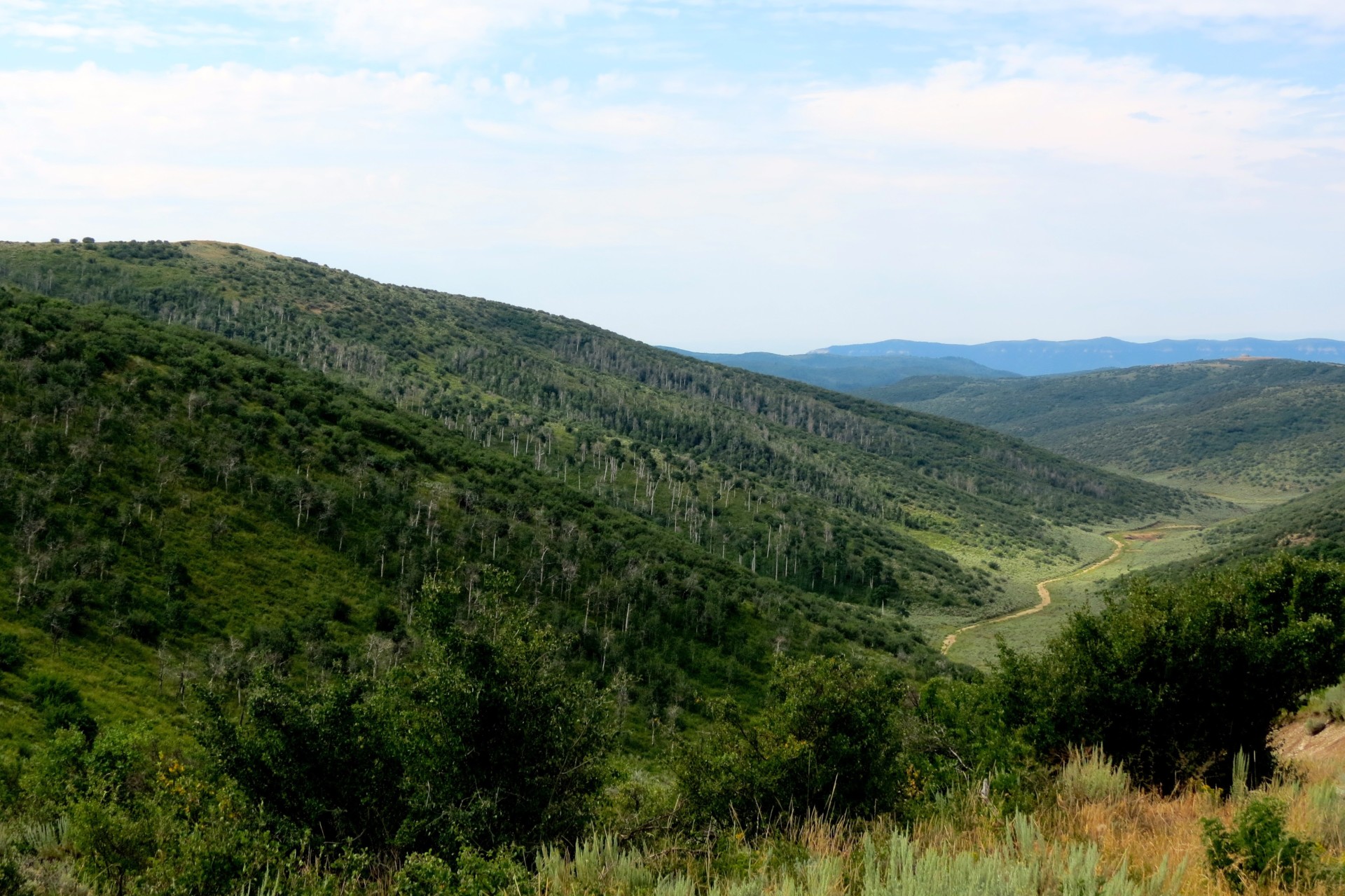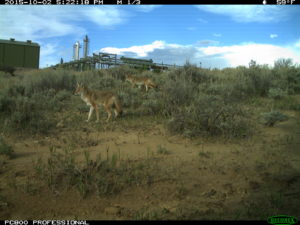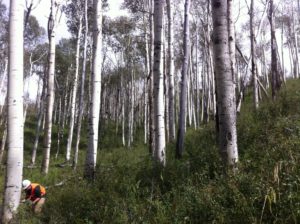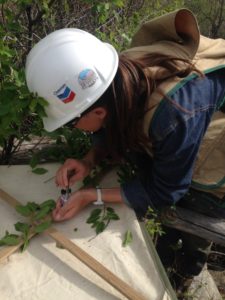
Kelsey Correia, who is pursuing a master’s degree in forest sciences, studied how aspens survive on the Roan Plateau in western Colorado.
Six graduate students from Warner College of Natural Resources recently completed two years of research on biological and ecological features of the Piceance Basin in northwestern Colorado, thanks to a $1 million grant from Chevron.
In late spring 2017, the students presented findings during a research symposium in Grand Junction, Colorado. Staff from government agencies who work in the region, including the Bureau of Land Management, Colorado Parks and Wildlife, and Colorado State Forest Service, were among those who attended the event, along with representatives from the Grand Junction offices of U.S. Sen. Cory Gardner, U.S. Sen. Michael Bennet, and U.S. Rep. Scott Tipton, as well as Garfield County Commissioner John Martin.
Chevron’s Michael DeBerry, who served as the company’s area manager until early 2016, said the partnership with CSU was created to help expand Chevron’s understanding of the ecology in the Piceance Basin and to identify opportunities that will enable the company to improve upon and manage the land in a sustainable way.
Research conducted in unique environmental setting
Most of the research was conducted on Chevron property in the region.
“We operate in unique environmental settings,” said DeBerry, pointing as an example to Chevron’s work on Barrow Island in Australia, where the company has constructed a large liquefied natural gas processing plant.

“Our company’s core values include protecting and preserving the environment we’re blessed to work in,” he said. “From the beginning, we have worked to minimize our footprint and impact in the Piceance Basin, while managing the property for multiple use.”
John Hayes, dean of CSU’s Warner College, said the partnership is the epitome of what land-grant institutions are formed to do. “Land-grant schools were not only founded with the idea of educating the masses, but also to create relevant, applied information that society can use to address hard issues,” he said.
The Chevron Graduate Fellows worked with CSU faculty on the following five projects:
- Stream and Riparian Communities: Researchers considered the impact of different disturbances on ecosystems close to river banks. The team assessed the impacts of a non-native species on bird habitats and diets, and the overall ecosystem.
- Energy Development and Large Mammals: The research team used camera traps to collect photos of mammals to assess if and how energy development affects the community.
- State-and-Transition Models: Researchers used models that depict different vegetation communities and showed the transitions between different types of vegetation. These models are used to make land management decisions. Researchers were particularly interested in the aspen stands on Chevron-owned land.
- Aspen Decline: The researchers assessed mortality and regrowth of aspen trees. Some aspen in this region of the state are not regenerating, as they do in most other regions. Chevron property had examples of both healthy and non-regenerating stands, which enabled the research team to learn more about the causes of the aspen decline.
- Headwater Streams: The research team sought to assess if energy development had an effect on the shapes of stream channels. They considered how road and site access could change the sediment influx to the stream, and thus could affect the shapes of the channels.
Some research findings could contribute to changes
Mark Paschke, Warner College research associate dean, said the research projects tested specific hypotheses. In most cases, the findings expanded upon existing data. Findings from some of the projects yielded specific data that Chevron can either study in more depth or use right away.

For example, the aspen research provided suggestions on how to improve the health of existing trees. The stream morphology research verified that many of Chevron’s storm water management practices are protecting streams, and the study of riparian areas found an unexpected benefit from an invasive plant species. All of the findings give Chevron additional information as the company considers how to manage the land for multiple purposes.
Dean Hayes said the partnership has been a positive experience for everyone involved. “For the students, the knowledge they gained, working with the energy industry and addressing important land management programs, the outcomes will last beyond the projects,” he said.
Paschke said the students benefited greatly from the hands-on research. “They were able to work on private property and learned critical skills in planning and organizing their work to achieve their goals, while following processes and procedures put in place by a large corporation,” he said.
Ranch manager paved way for new learning experiences
One of the key Chevron contacts for the students was the company’s ranch manager, Craig Tysse. He provided an orientation for CSU students, explained rules of operation on the land, took them on driving tours in rugged terrain to find suitable research locations, and served as a resource throughout the course of the research projects. The student researchers often worked seven days per week.

Hannah Riedl, CSU graduate student, said she was grateful for the help and guidance from Tysse and others at Chevron. “Our research on Chevron’s property went smoothly with Craig’s help,” she said. “He made sure we knew what operations Chevron had going on the ground, and made sure Chevron employees were aware of what we were doing on their property. Besides providing training and tours for me, my collaborator, and our technicians, he also took the time to teach us about the geology of the region. If you crack open rocks in those canyons, you can watch the petroleum evaporate.”
Chevron owns more than 100,000 acres of land in the Piceance Basin which is managed for multiple uses, including agriculture and natural resource development.
“We recognize that this property is a special place, and we strive to be good stewards of the land,” said DeBerry. “Over the years, we’ve worked to improve the quality of the habitat and to minimize our footprint. Our goal is for our Piceance Basin land to be a sustainable working landscape that supports a thriving ecosystem.”
In closing remarks delivered at the symposium, DeBerry said the research presented will help advance the science.
“This research adds to the body of knowledge that we have about the Western Slope of Colorado,” he said. “The information presented prompted a number of points of affirmation. Yes, in some places, we’ve made great decisions. How do we examine and look at other topics? That’s what science is about. From a scientific standpoint, we are generating insight, information and knowledge that will be beneficial to all of us.”
Cary Baird, community engagement specialist at Chevron, contributed to this story.